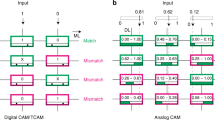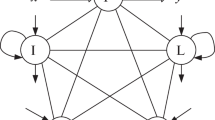Abstract
This report discusses the capability of an associative memory to search some useful data bases. The report utilizes a simplified cell and a collection of “assembler language” instructions to show how sets and trees can be searched in the memory. An OR rail and an EXCLUSIVE-OR rail are discussed in relation to their use to search-ordered and unordered sets, strings, and tree data structures. Linked data structures are also discussed. This report is oriented toward the software aspects of the associative memory to lead to further research in the design of high-level languages that utilize the capability of the rails.
Similar content being viewed by others
References
B. A. Crane and J. A. Githens, “Bulk processing in distributed logic memory,”IEEE Trans. Electronic Computers EC-14:186–196 (1965).
G. Estrin and R. H. Fuller, “Algorithms for content-addressable memories,”Proc. WJCC, pp. 118–130 (1963).
J. A. Feldman and P. D. Rover, “Analgol-based associative language,” Stanford Artificial Intelligence Project Memo AI-66, August 1968.
R. H. Fuller and R. M. Bird, “An associative parallel processor with application to picture processing,”Proc. FJCC, pp. 105–116 (1965).
R. H. Fuller and G. Estrin, “Some applications for content addressable memories,”Proc. FJCC, pp. 495–505 (1963).
R. S. Gains and C. Y. Lee, “An improved cell memory,”IEEE Trans. Electronic Computers EC-14:72–75 (1965).
K. E. Iverson,A Programming Language (Wiley, New York, 1962).
C. Y. Lee, “Intercommunicating cells, basis for a distributed logic computer,”Proc. FJCC, pp. 130–136 (1962).
C. Y. Lee and M. C. Paull, “A content addressable distributed logic memory with applications to information retrieval,”Proc. IEEE 51:924–932 (1963).
M. H. Levin, “Retrieval of ordered lists from a content addressed memory,”RCA Rev. 23: 215–229 (1962).
G. J. Lipovski, “The architecture of a large distributed logic associative processor,” Coordinated Science Laboratory, R-424, July 1969.
G. J. Lipovski, “On data structures in associative memories,”SIGPLAN Notices 6(2):346–365 (1971).
G. J. Lipovski, “The architecture of a large associative processor,”Proc. SJCC, pp. 385–396 (1970).
B. T. McKeever, “The associative memory structure,”Proc. FJCC, Part I, pp. 371–388 (1965).
H. O. McMahon and A. E. Slade, “A cyrotron catalof memory system,”Proc. FJCC, p. 120 (1956).
R. Morris, “Scatter storage techniques,”Commun. ACM, No. II, pp. 38–44 (1968).
N. K. Natarajan and P. A. V. Thomas, “A multiaccess associative memory,”IEE Trans. Computers C-18:424–428 (1969).
L. G. Roberts, “Graphical communication and control languages,” Second Congress on Information Systems Sciences, Hot Spring, Virginia, 1964.
G. Salton,Automatic Information Organization and Retrieval, (McGraw-Hill, New York, 1968).
D. A. Savitt, H. H. Love, and R. E. Troop, “ASP—A new concept in language and machine organization,”Proc. SJCC, pp. 87–102 (1967).
D. A. Savitt, H. H. Love, and R. E. Troop, “Association-strong processor study,” Hughes Aircraft Technical Report No. TR-66-174 (AD-488538), June 1966.
A. E. Slade, “The woven cryotron memory,” inProc. Int. Symp. on the Theory of Switching (Harvard Univ. Press, 1959).
J. E. Smathers, “Distributed logic memory computer for process control,” Ph.D. Dissertation, Oregon State University, June 1969.
J. N. Sturman, “An iteratively structured general-purpose digital computer,”IEEE Trans. Computers C-17:2–9 (1968).
Author information
Authors and Affiliations
Rights and permissions
About this article
Cite this article
Lipovski, G.J. Data structures in context-addressed cellular memories. International Journal of Computer and Information Sciences 1, 329–353 (1972). https://doi.org/10.1007/BF00987252
Received:
Issue Date:
DOI: https://doi.org/10.1007/BF00987252




